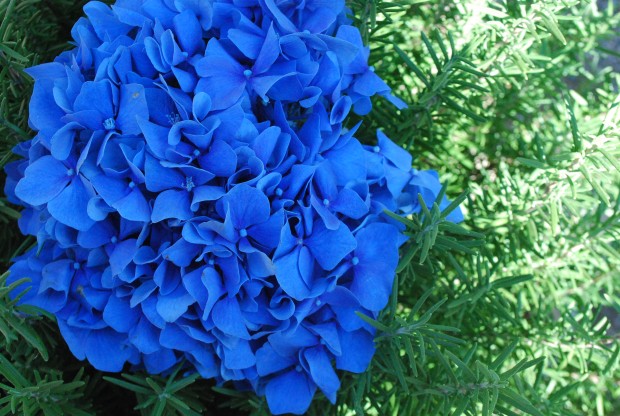 There are lots of other hydrangea cultivars available besides Limelight and Little Lime. I would have no problem growing this electric blue Dutch hydrangea, but it is only available to me as a cut flower. My zone is noted for its unspeakably cold winters. Hydrangeas that would prosper in California or Virginia would sooner or later succumb to the cold. I routinely see landscapes that have what I call “florist’s hydrangeas”-presumably purchased from a greenhouse at Easter time-planted in ground. These hydrangeas rarely bloom again once planted in the ground here. The plants can survive the winters, but the flower buds are killed by the cold.
There are lots of other hydrangea cultivars available besides Limelight and Little Lime. I would have no problem growing this electric blue Dutch hydrangea, but it is only available to me as a cut flower. My zone is noted for its unspeakably cold winters. Hydrangeas that would prosper in California or Virginia would sooner or later succumb to the cold. I routinely see landscapes that have what I call “florist’s hydrangeas”-presumably purchased from a greenhouse at Easter time-planted in ground. These hydrangeas rarely bloom again once planted in the ground here. The plants can survive the winters, but the flower buds are killed by the cold.
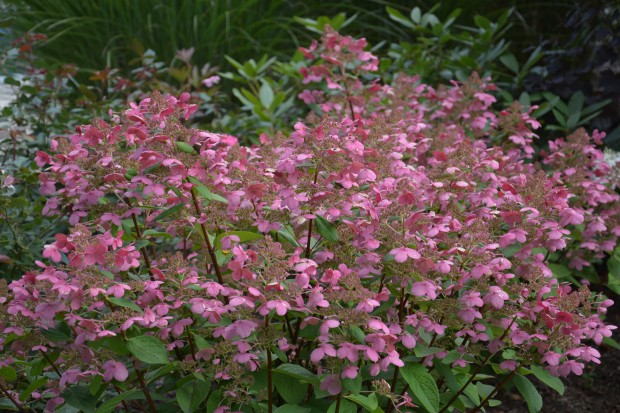 There has been a lot of interest and a lot of hybridizing of hydrangeas going on in recent years-especially in the area of hydrangeas other than white. It is no mystery why. People buy shrubs that have showy flowers, leaves or fruit. The sales of rhododendrons in my zone must be considerable. In the spring, I see newly planted shrubs in full bloom in plenty of yards. But few gardeners in my area have success with them. They like acid well drained soil, and regular moisture. They like sun, but protection from winter winds. A case in point? I have tried, on more occasions than I care to admit to, added to the established rhododendrons on the north side of my house without success. Where am I going with this? People are more likely to buy showy blooming shrubs that come with the promise that they are easy to grow. It is hard to argue with success. This pink hydrangea recently photographed in a client’s yard-I have no idea the name. I have to admit it looked great.
There has been a lot of interest and a lot of hybridizing of hydrangeas going on in recent years-especially in the area of hydrangeas other than white. It is no mystery why. People buy shrubs that have showy flowers, leaves or fruit. The sales of rhododendrons in my zone must be considerable. In the spring, I see newly planted shrubs in full bloom in plenty of yards. But few gardeners in my area have success with them. They like acid well drained soil, and regular moisture. They like sun, but protection from winter winds. A case in point? I have tried, on more occasions than I care to admit to, added to the established rhododendrons on the north side of my house without success. Where am I going with this? People are more likely to buy showy blooming shrubs that come with the promise that they are easy to grow. It is hard to argue with success. This pink hydrangea recently photographed in a client’s yard-I have no idea the name. I have to admit it looked great.
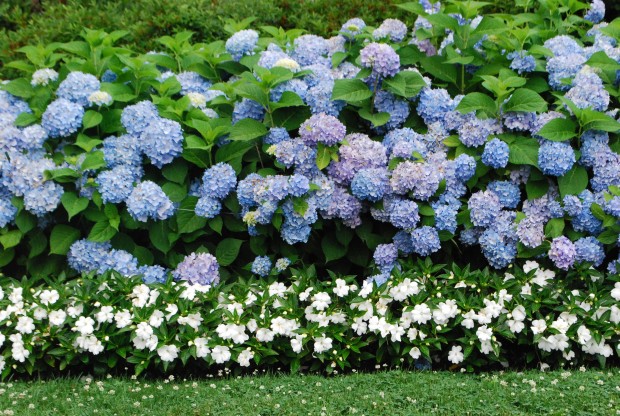 I have planted lots of Nikko blue hydrangeas. The places where they thrive and bloom heavily-just a handful. This property-I have not one clue why they do so well, year after year. Just down the street-big green shrubs with a few flowers here and there. Sparsely representing is not a good look for a summer blooming hydrangea.
I have planted lots of Nikko blue hydrangeas. The places where they thrive and bloom heavily-just a handful. This property-I have not one clue why they do so well, year after year. Just down the street-big green shrubs with a few flowers here and there. Sparsely representing is not a good look for a summer blooming hydrangea.
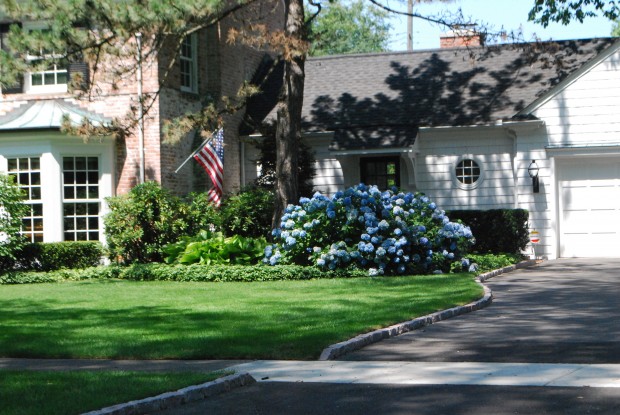 A community on Lake Saint Clair, where I do a fair amount of work, those hydrangeas other than white are summer swell. This is one old Nikko blue hydrangea, blooming to beat the band. What it is about this environment that favors this hydrangea-I have no idea. I do have clients who faithfully acidify their hydrangeas in hopes of those prized blue blooms. Has this shrub had that level of care, or does it succeed on the strength of its location and the composition of the soil? I wonder.
A community on Lake Saint Clair, where I do a fair amount of work, those hydrangeas other than white are summer swell. This is one old Nikko blue hydrangea, blooming to beat the band. What it is about this environment that favors this hydrangea-I have no idea. I do have clients who faithfully acidify their hydrangeas in hopes of those prized blue blooms. Has this shrub had that level of care, or does it succeed on the strength of its location and the composition of the soil? I wonder.
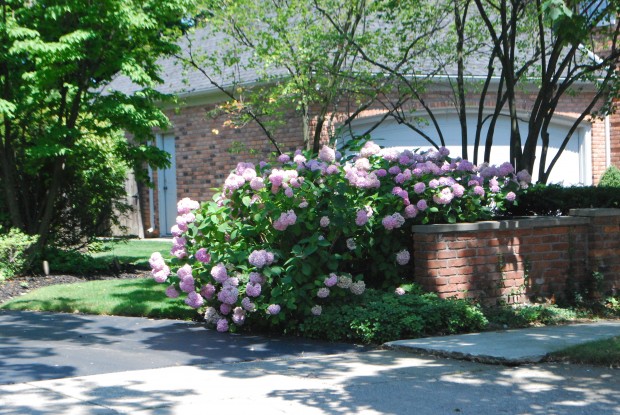 The same neighborhood is all abloom with pink hydrangeas. This is a pair of shrubs. I have no idea of the cultivar. It cannot be a new variety, as these shrubs are old. On my side of town, the west side, I never see pink hydrangeas that perform like this. There are lots of new cultivars. All Summer Beauty, Endless Summer-and so on. I will admit I shy away from them. Any plant material I design into a landscape needs to have a reasonable chance of success. A client who has success may decide to move on to being a passionate gardener. Part of my my pleasure in my job is to see this happen. Sometimes I install a landscape, and I have to persuade a client to take ownership. When there are successes, they brush me off, and move on. I like this.
The same neighborhood is all abloom with pink hydrangeas. This is a pair of shrubs. I have no idea of the cultivar. It cannot be a new variety, as these shrubs are old. On my side of town, the west side, I never see pink hydrangeas that perform like this. There are lots of new cultivars. All Summer Beauty, Endless Summer-and so on. I will admit I shy away from them. Any plant material I design into a landscape needs to have a reasonable chance of success. A client who has success may decide to move on to being a passionate gardener. Part of my my pleasure in my job is to see this happen. Sometimes I install a landscape, and I have to persuade a client to take ownership. When there are successes, they brush me off, and move on. I like this.
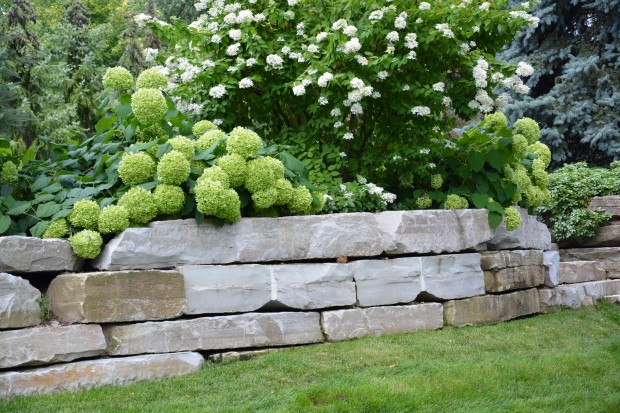 This discussion takes me back to the white hydrangeas. Hydrangea arborescens “Annabelle” is an old stand by. Plagued by giant flower heads, and weak stems, this cultivar weeps. It is not unusual to see them hang over to the ground. I rarely plant them anymore-I much prefer the Limelights. They are so easy, in every regard. But Annabelle planted on top of a wall is a really great look. Those flowers soften an elevated garden space.
This discussion takes me back to the white hydrangeas. Hydrangea arborescens “Annabelle” is an old stand by. Plagued by giant flower heads, and weak stems, this cultivar weeps. It is not unusual to see them hang over to the ground. I rarely plant them anymore-I much prefer the Limelights. They are so easy, in every regard. But Annabelle planted on top of a wall is a really great look. Those flowers soften an elevated garden space.
The white hydrangeas- Limelight, Little Lime, hydrangea paniculata, Annabelle-and the strikingly foliaged oak leaf hydrangea- they prosper in my zone. Pictured above, a framed herbaria from a gardener, and her artist husband in Italy. Rob bought a series of framed hydrangea herbaria from them. It is a good thing to have a big love for the garden. The design, the planting, the care, the years-magical. I only grow Limelight hydrangeas. It is enough for me-how willing they are to grow and bloom profusely in my garden. This framed herbaria captures what I could not write in words about hydrangeas in summer. Beautiful.

Luckily, I live in Ga where we can grow most hydrangeas. What is the name of the electric blue hydrangea that you can only order from florists? I really enjoy your website.
Cheryl, I only know this as giant Dutch blue hydrangea. Maybe if you searched for it on the internet, you could get more information. Thanks, Deborah
Your last post talked about pruning back limelight twice. After two floppy seasons I was planning on pruning back my annabelles this fall (outer canes longer than inner canes AND adding some additional support in the early spring (not surre what at theis point). Will the double pruning work for the annabelles too?
Nella, I don’t grow Annabelle, so I don’t know if it will work. But one crucial thing to consider-Annabelle is June blooming here. If you prune in the fall, are you pruning off flower buds? Having a support system in place very early on-like peony hoops-would help a lot. Deborah
It is my experience, that you can cut Annabelle hydrangea back at any time of the year, spring, summer, or fall. The old stems don’t flop as bad. They will rebloom if you trim them in the summer. I cut off the spent blooms in the late spring so birds can have them for nests. Annabelles have gotten a bad rap as floppers. Actually, I think gardeners try to put them in bad locations. They do not make good foundation plants. I inherited a large bed of Annabelles 50 feet-long by 20 feet-wide full of Annabelles and holly. I live in zone 5. The holly provides great winter interest. The edge of the large bed is field stone, and it is a buffer to the street. Nothing is planted too close to the edge of the stone. There are sailor posts to break-up the stretch . The lawn-side is edged with pachysandra to make the mowing easy. The Annabelles are beautiful and I do nothing to them. They bloom early in June (before the dayllies) and the blooms turn from bright white to lime green as they age. They have plenty of room to flop. I throw mulch where I can see bare ground. The walkers can’t stop talking about them. They call me the Annabelle lady. I have been called worse:)
Blue hydr’s in St. Clair, MI? without adding an additive, it must be the salt air – this area is salt driven (original home of Diamond Salt – remember the girl with the umbrella? – am certainly dating myself here) pus, Mt Clemens – about 20 miles south – was known for sulphur baths/spas – suphur + salt = blue hydrangeas: same as in Martha’s Vineyard – all blue .
Hydrangeas grown in acidic soil will be blue, whereas hydrangeas grown in basic soil will tend more towards pink. Changing the ph of one’s soil is a tough thing to maintain. I favor just letting the natural soil make the decision.
Deborah,
You mention the Oakleaf for your zone, but you prefer the Limelight. The Oakleaf will also grow large, I’m sure you’re aware. May I ask why you don’t use it? I keep looking for it in your installations. This post makes it clear you prefer Limelight. In my zone, 6b,I find it to be a long-lasting and reliable bloomer. I enjoy the bronzing leaves and woody structure in winter months.
Thank you, Gina
Dear Gina, I prefer the hydrangea that will do the best in the space in question. I feel sure I have posted some landscape photos that show them. I have one in my own yard that must be 15 feet tall. best, Deborah